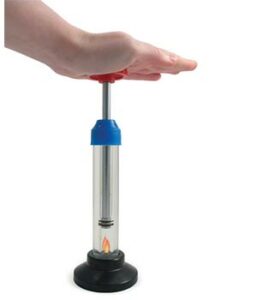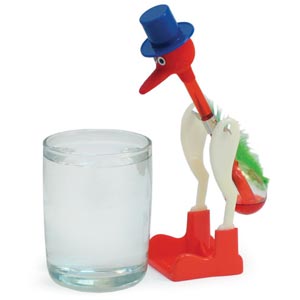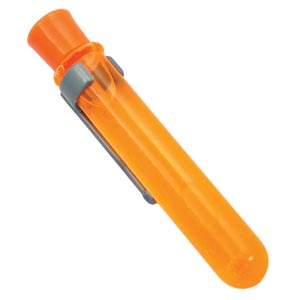 by: Tami O’Connor
by: Tami O’Connor
The fire syringe sold by Educational Innovations is a wonderfully simple, yet impressive and dramatic demonstration that increasing pressure on a gas increases its temperature. 
The fire piston, predecessor to the fire syringe was once used as a means of kindling fire in prehistoric Southeast Asia and the Pacific Islands. The apparatus used a hollow cylinder, sealed at one end and open on the other. A piston fit snugly in the cylinder and by sharply compressing the air, the tinder would ignite. This is an example of compression ignition.
This is also the principle behind a diesel engine. Unlike gasoline engines, diesel engines do not have spark plugs. Rather, the upward movement of the piston compresses the fuel vapor and increases the temperature to the point of combustion. That forces the piston down thus turning the drive shaft.
Here is how best to operate a fire syringe:
Place the piston into the mouth of the cylinder and thread the collar back onto the syringe. Place the syringe on a sturdy table. Get a firm grip on the handle and force the piston straight down, FAST AND HARD. The compression of the air causes the temperature of the gas to rise rapidly, igniting the material at the base of the cylinder. If the compression is done too slowly the heat will dissipate before ignition will occur. This can take a little practice, so don’t be discouraged if it doesn’t flash the first time you try it. It may be helpful to prepare a few pieces of toilet paper or cotton fiber in advance. Read the rest of this entry »
 The normal way to operate a drinking bird is to have him dip his head in water. The water on his felt head evaporates, leaving the head cooler than the bird’s body. The liquid flowing into the upper bulb (head) changes the center of gravity, causing the bird to tip forward. Liquid flows back to the bottom bulb and the bird returns to his upright position. As long as an adequate temperature difference (head cooler than body) remains, the cycle will repeat.
The normal way to operate a drinking bird is to have him dip his head in water. The water on his felt head evaporates, leaving the head cooler than the bird’s body. The liquid flowing into the upper bulb (head) changes the center of gravity, causing the bird to tip forward. Liquid flows back to the bottom bulb and the bird returns to his upright position. As long as an adequate temperature difference (head cooler than body) remains, the cycle will repeat.



 Posted by Tami O'Connor
Posted by Tami O'Connor 

 3. Notice how AMBULANCE is written. Why is it always written this way on the front of the emergency vehicle?
3. Notice how AMBULANCE is written. Why is it always written this way on the front of the emergency vehicle? 

 by: Tami O’Connor
by: Tami O’Connor